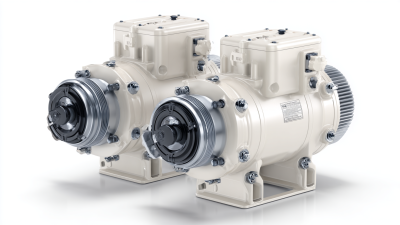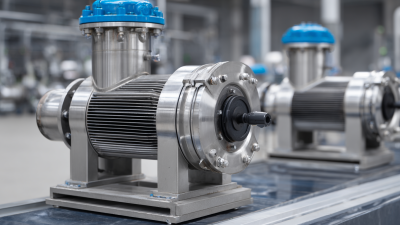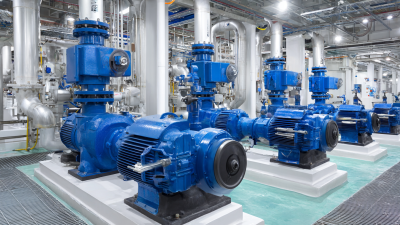Sealless Pumps for a Safer and Greener World


In recent years, the importance of vertical pumps has significantly increased across various industrial applications, driven by the rising demand for efficient fluid management solutions. According to a report by ResearchAndMarkets, the global vertical pump market is projected to grow at a CAGR of 4.5% from 2021 to 2026, reaching a value of approximately $5 billion. This growth is attributed to their space-saving design, superior performance, and adaptability to different environments, making them ideal for sectors such as water treatment, oil and gas, and chemical processing.

Understanding the mechanics of vertical pumps not only helps in selecting the right pump for specific applications but also enhances operational efficiency and longevity. As industries continue to evolve, mastering the intricacies of vertical pump design and functionality will be crucial for maximizing productivity and minimizing energy consumption.
Vertical pump design plays a crucial role in enhancing efficiency across various applications, particularly in the chemical and industrial sectors. Understanding the design principles of vertical pumps involves analyzing key factors like flow dynamics, material selection, and the mechanical configurations that ensure optimal performance. The innovative engineering behind these pumps allows them to operate effectively under high-pressure conditions and accommodate a diverse range of fluids, including corrosive substances.
Recent developments in pump technology highlight the importance of continuous improvement in design principles. For instance, advances in spiral tube pumps reveal how specific parameters—such as geometry and fluid velocity—can significantly impact performance. Companies are increasingly focusing on enhancing the capabilities of vertical pumps to meet the rigorous demands of industries such as sulfuric and phosphoric acid production. By leveraging insights from experimental studies and adopting cutting-edge engineering techniques, vertical pumps are evolving to provide greater efficiency and reliability in their applications.
This chart illustrates the efficiency percentages of vertical pumps across various applications. As observed, mining applications tend to achieve the highest efficiency, while wastewater management lags somewhat behind. Understanding these variations can help in selecting the right pump for specific needs.
When assessing the efficiency of vertical pumps, it's essential to focus on key performance metrics including hydraulic efficiency, volumetric efficiency, and overall pump efficiency. Hydraulic efficiency refers to the percentage of mechanical energy converted into hydraulic energy while moving fluid. A high hydraulic efficiency indicates effective fluid movement with minimal energy loss due to friction and turbulence. Volumetric efficiency, on the other hand, measures the actual flow rate compared to the theoretical flow rate, highlighting how well the pump can deliver the intended volume of fluid.
**Tip:** To enhance hydraulic efficiency, consider optimizing impeller design and ensuring proper alignment during installation. Small adjustments can significantly reduce energy losses.
Overall pump efficiency combines both hydraulic and volumetric efficiencies into a single performance metric, providing insight into the overall effectiveness of the pump system. Regular maintenance practices, such as checking for wear and leaks, can also maintain or improve efficiency metrics over time. By meticulously monitoring these parameters, companies can ensure their vertical pumps operate at peak performance, leading to increased productivity and reduced operational costs.
**Tip:** Implementing a routine performance assessment can proactively identify potential issues, preventing costly downtime and prolonging pump life.
Vertical pumps are vital components in a variety of industries, designed to handle fluids efficiently in both commercial and industrial applications. One of the most common uses of vertical pumps is in the water and wastewater treatment sector, where they facilitate the movement of water through various processes, ensuring clean and safe water supply. Their compact design allows them to fit into limited spaces, making them ideal for installations where horizontal pumps might not be feasible.
In the oil and gas industry, vertical pumps play a crucial role in the extraction and transportation of crude oil and refining processes. They are particularly effective in handling high-viscosity fluids, which often require specialized configurations to maintain efficiency. Additionally, vertical pumps are frequently utilized in the chemical processing industry, where they are used for transferring corrosive and hazardous fluids, providing a safe and effective means of fluid movement while minimizing contamination risks. These applications highlight the versatility and reliability of vertical pumps across various sectors, emphasizing their importance in modern industrial operations.
Routine maintenance of vertical pumps is crucial to ensure optimal performance and longevity. Regular inspections can help identify potential issues before they escalate, saving both time and money. Check for signs of wear or corrosion on components, as well as any unusual noises during operation. Additionally, ensure that seals and gaskets are in good condition to prevent leaks, which can lead to decreased efficiency and increased operational costs.
**Tips:** Always adhere to the manufacturer’s guidelines regarding maintenance schedules. Implementing a structured maintenance program allows for timely servicing, reducing the likelihood of unexpected downtime. Consider maintaining a log of maintenance activities, which can help track performance trends and identify areas needing attention.
Another key aspect of pump maintenance is monitoring the alignment and vibration levels. Misalignment can lead to excessive wear and tear, while abnormal vibrations may indicate underlying issues affecting pump efficiency. Performing regular alignment checks and utilizing vibration analysis tools can help maintain the pump’s operational integrity and improve overall efficiency.
**Tips:** Invest in vibration monitoring equipment for real-time data, which can lead to proactive maintenance decisions. Engage trained personnel to conduct these analyses, as their expertise can significantly enhance the performance and reliability of your vertical pumps.
| Pump Type | Efficiency (%) | Maximum Flow Rate (GPM) | Typical Applications | Maintenance Frequency (Months) |
|---|---|---|---|---|
| Submersible Pump | 85 | 600 | Water Supply, Sewage | 6 |
| Vertical Turbine Pump | 90 | 800 | Irrigation, Industrial Processes | 12 |
| Centrifugal Pump | 75 | 1000 | Water Treatment, Chemical Processing | 9 |
| Positive Displacement Pump | 80 | 500 | Food Industry, Oil, and Gas | 4 |
Recent advancements in vertical pump technology are reshaping the efficiency and reliability of fluid transfer systems across various industries. Innovations like the introduction of advanced materials and design enhancements have led to significant improvements in pump durability and operational efficiency. For instance, according to a report from the Hydraulic Institute, modern vertical pumps can achieve efficiency ratings exceeding 90%, reducing energy consumption and operational costs. This level of efficiency not only minimizes environmental impact but also extends the lifecycle of the equipment.
Moreover, the integration of smart technology into vertical pumps has opened new avenues for applications. The utilization of IoT sensors allows for real-time monitoring and predictive maintenance, which can reduce downtime by up to 30%, as stated in a recent study by McKinsey & Company. These innovations enable industries such as water treatment, HVAC, and fire protection to optimize their systems and improve functionality. As vertical pump technology continues to evolve, its applications will likely expand, fostering enhanced sustainability and operational excellence in various sectors.





